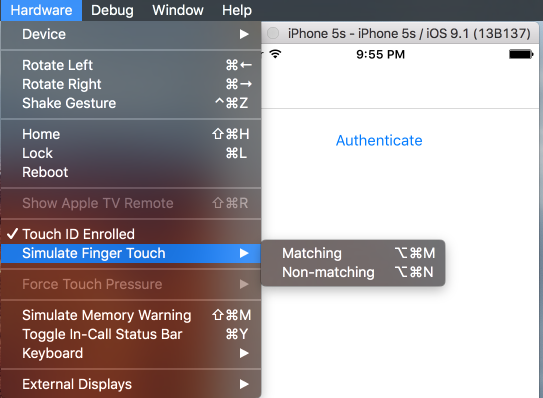 Fingerprint plugin for Xamarin
Fingerprint plugin for Xamarin
Xamarin and MvvMCross plugin for accessing the fingerprint sensor.
| Type | Stable | Pre release |
|---|---|---|
| vanilla |  |
 |
| MvvmCross |  |
 |
Support
If you like the quality and code you can support me
Thanks!
The plugin supports the listed platforms.
| Platform | Version |
|---|---|
| Xamarin.Android | 4.4 |
| Xamarin.iOS | 8.0 |
| Xamarin.Mac | 10.12 |
| Windows UWP | 10 |
Setup
iOS
Add NSFaceIDUsageDescription to your Info.plist to describe the reason your app uses Face ID. (see Documentation). Otherwise the App will crash when you start a Face ID authentication on iOS 11.3+.
<key>NSFaceIDUsageDescription</key>
<string>Need your face to unlock secrets!</string>Android
Set Target SDK version
The target SDK version has to be >= 6.0. I recomment to use always the latest stable SDK version, if possible. You can set the target SDK version in your Android project properties.
Request the permission in AndroidManifest.xml
The first line is for the standard Android API and the second for Samsung devices using the Pass API.
<uses-permission android:name="android.permission.USE_FINGERPRINT" />
<uses-permission android:name="com.samsung.android.providers.context.permission.WRITE_USE_APP_FEATURE_SURVEY" />Set the resolver of the current Activity
Skip this, if you use the MvvMCross Plugin or don't use the dialog.
We need the current activity to display the dialog. You can use the Current Activity Plugin from James Montemagno or implement your own functionality to retrieve the current activity. See Sample App for details.
CrossFingerprint.SetCurrentActivityResolver(() => CrossCurrentActivity.Current.Activity);Usage
Example
vanilla
var result = await CrossFingerprint.Current.AuthenticateAsync("Prove you have fingers!");
if (result.Authenticated)
{
// do secret stuff :)
}
else
{
// not allowed to do secret stuff :(
}using MvvMCross
var fpService = Mvx.Resolve<IFingerprint>(); // or use dependency injection and inject IFingerprint
var result = await fpService.AuthenticateAsync("Prove you have mvx fingers!");
if (result.Authenticated)
{
// do secret stuff :)
}
else
{
// not allowed to do secret stuff :(
}Xamarin University public lecture
API
The API is defined by the IFingerprint interface:
/// <summary>
/// Checks the availability of fingerprint authentication.
/// Checks are performed in this order:
/// 1. API supports accessing the fingerprint sensor
/// 2. Permission for accessint the fingerprint sensor granted
/// 3. Device has sensor
/// 4. Fingerprint has been enrolled
/// <see cref="FingerprintAvailability.Unknown"/> will be returned if the check failed
/// with some other platform specific reason.
/// </summary>
/// <param name="allowAlternativeAuthentication">
/// En-/Disables the use of the PIN / Passwort as fallback.
/// Supported Platforms: iOS, Mac
/// Default: false
/// </param>
Task<FingerprintAvailability> GetAvailabilityAsync(bool allowAlternativeAuthentication = false);
/// <summary>
/// Checks if <see cref="GetAvailabilityAsync"/> returns <see cref="FingerprintAvailability.Available"/>.
/// </summary>
/// <param name="allowAlternativeAuthentication">
/// En-/Disables the use of the PIN / Passwort as fallback.
/// Supported Platforms: iOS, Mac
/// Default: false
/// </param>
/// <returns><c>true</c> if Available, else <c>false</c></returns>
Task<bool> IsAvailableAsync(bool allowAlternativeAuthentication = false);
/// <summary>
/// Requests the authentication.
/// </summary>
/// <param name="reason">Reason for the fingerprint authentication request. Displayed to the user.</param>
/// <param name="cancellationToken">Token used to cancel the operation.</param>
/// <returns>Authentication result</returns>
Task<FingerprintAuthenticationResult> AuthenticateAsync(string reason, CancellationToken cancellationToken = default(CancellationToken));
/// <summary>
/// Requests the authentication.
/// </summary>
/// <param name="authRequestConfig">Configuration of the dialog that is displayed to the user.</param>
/// <param name="cancellationToken">Token used to cancel the operation.</param>
/// <returns>Authentication result</returns>
Task<FingerprintAuthenticationResult> AuthenticateAsync(AuthenticationRequestConfiguration authRequestConfig, CancellationToken cancellationToken = default(CancellationToken));The returned FingerprintAuthenticationResult contains information about the authentication.
/// <summary>
/// Indicatates whether the authentication was successful or not.
/// </summary>
public bool Authenticated { get { return Status == FingerprintAuthenticationResultStatus.Succeeded; } }
/// <summary>
/// Detailed information of the authentication.
/// </summary>
public FingerprintAuthenticationResultStatus Status { get; set; }
/// <summary>
/// Reason for the unsucessful authentication.
/// </summary>
public string ErrorMessage { get; set; }Example
vanilla
var result = await CrossFingerprint.Current.AuthenticateAsync("Prove you have fingers!");
if (result.Authenticated)
{
// do secret stuff :)
}
else
{
// not allowed to do secret stuff :(
}using MvvMCross
var fpService = Mvx.Resolve<IFingerprint>(); // or use dependency injection and inject IFingerprint
var result = await fpService.AuthenticateAsync("Prove you have mvx fingers!");
if (result.Authenticated)
{
// do secret stuff :)
}
else
{
// not allowed to do secret stuff :(
}mocking in unit tests
//Create mock with LigthMock (http://www.lightinject.net/)
var mockFingerprintContext = new MockContext<IFingerprint>();
var mockFingerprint = new CrossFingerprintMock(mockFingerprintContext);
mockFingerprintContext.Current = mockFingerprint;iOS
Limitations
You can't create a custom dialog. The standard iOS Dialog will be shown.
iOS 9+ only
- cancelable programmatically with passed CancellationToken
- custom fallback button title
iOS 10+ only
- custom cancel button title
Android
Limitations
You can't use the alternative authentication method.
Configuration
If you don't like the default dialog, you can easily customize it. You have to inherit from FingerprintDialogFragment e.g. like:
public class MyCustomDialogFragment : FingerprintDialogFragment
{
public override View OnCreateView(LayoutInflater inflater, ViewGroup container, Bundle savedInstanceState)
{
var view = base.OnCreateView(inflater, container, savedInstanceState);
view.Background = new ColorDrawable(Color.Magenta); // make it fancyyyy :D
return view;
}
}And somewhere in your code set your custom dialog fragment:
CrossFingerprint.SetDialogFragmentType<MyCustomDialogFragment>();UWP
Limitations
You can't use the alternative authentication method.
Testing on Simulators
iOS
With the Hardware menu you can
- Toggle the enrollment status
- Trigger valid (⌘ ⌥ M) and invalid (⌘ ⌥ N) fingerprint sensor events
Android
- start the emulator (Android >= 6.0)
- open the settings app
- go to Security > Fingerprint, then follow the enrollment instructions
- when it asks for touch
- open command prompt
telnet 127.0.0.1 <emulator-id>(adb devicesprints "emulator-<emulator-id>")finger touch 1finger touch 1
Sending fingerprint sensor events for testing the plugin can be done with the telnet commands, too.
Note for Windows users: You have to enable telnet: Programs and Features > Add Windows Feature > Telnet Client
Nice to know
ProGuard
If you use the plugin with Link all, Release Mode and ProGuard enabled, you may have to add the follwoing rules to your proguard.cfg.
-dontwarn com.samsung.**
-keep class com.samsung.** {*;}





